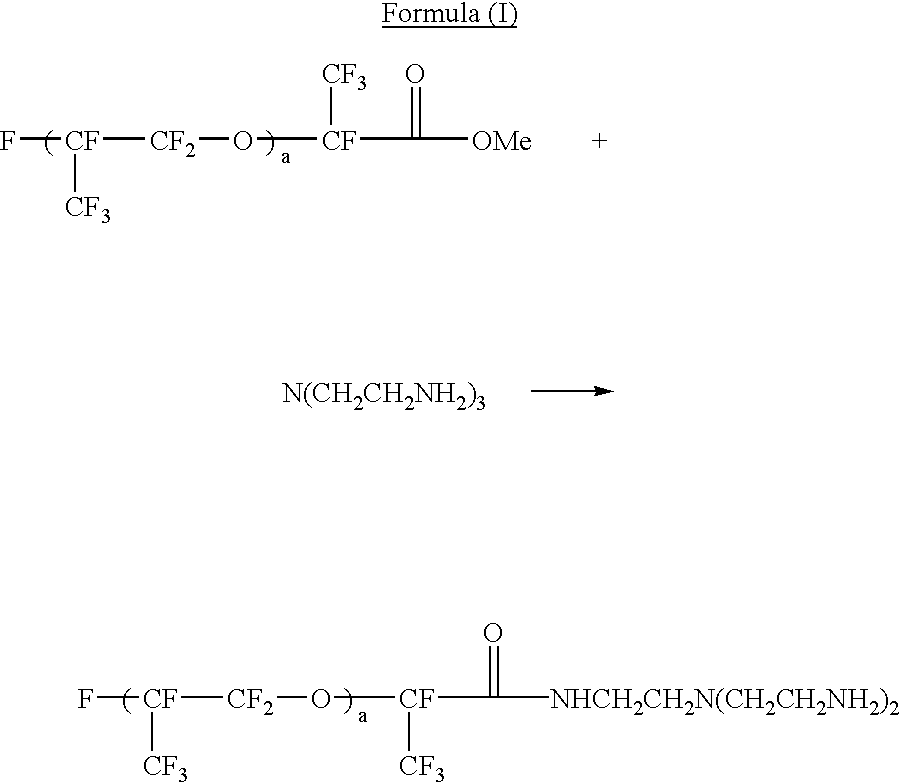Electrophoretic dispersion with a fluorinated solvent and a charge controlling agent
a fluorinated solvent and electrophoretic technology, applied in the field of electrophoretic dispersion, can solve the problems of consuming a great deal of power for the backlight and color filter used in the device, reducing the efficiency of the backlight system, etc., to achieve high dispersion stability, low sedimentation or creaming rate, and high hiding power or light scattering efficiency
- Summary
- Abstract
- Description
- Claims
- Application Information
AI Technical Summary
Benefits of technology
Problems solved by technology
Method used
Image
Examples
example 2
[0104]The procedure of Example 1 was repeated, except that the acrylic particle was precoated with a basic copolymer of 4-vinylpyridine (90%) and butyl methacrylate (10%) (PVPyBMA) (Aldrich) by dispersing 20 parts of the acrylic particle in 20 parts of a 5% solution of the copolymer in methanol using a homogenizer (PowerGen® 700) for 1 hour, followed by ultrasonication (Sonic Dismembrator® 550) for 45 minutes. The coated acrylic particle dispersion was spray dried, ground with a mortar, dispersed into a solution containing 0.1 parts of a perfluorocarboxylic acid, Krytox® 157FSL (DuPont Performance lubricants, Deepwater, N.J.) and 34.2 parts of a 1% solution of fluorinated blue dye FC-3275 (3M, Specialty Chemicals Division, St. Paul, Minn.) in HT200 (Ausimont, Thorofare, N.J.) and evaluated as described in Example 1. The dispersion showed a switching rate of 7 Hz at 100V with a significantly improved contrast ratio.
example 4
[0106]The procedure of Example 3 was repeated, except that the TiO2 particles TINT-AYD® PC9003 were precoated with a basic copolymer (PVPyBMA) of 4-vinylpyridine (90%) and butyl methacrylate (10%) (Aldrich). The PC-9003 particles (50 parts) were mixed with 25 parts of ethanol and 25 parts of 10% solution of the PVPyBMA copolymer in methanol, homogenized for 5 minutes and then ultrasonicated for 10 minutes. The resultant slurry (12 parts) was added into 100 parts of a solution containing 1.2% of Krytox® 157FSH in HT-200 and homogenized at room temperature (10K speed) for 30 minutes. The alcohol was stripped off at 80° C. and the dispersion was further ultrasonicated for 30 minutes. The blue dye FC-3275 (0.8% based on the dispersion) was added to the above dispersion and the resultant fluid was evaluated as described in Example 3. An acceptable contrast ratio was observed and the switching rates were 12, 2, and about 1 Hz at 100, 20 and 10 volts respectively. Results are shown in Tabl...
example 5
[0107]The procedure of Example 4 was repeated, except that the concentration of the basic poly(4-vinylpyridine-co-butyl methacrylate) (PVPyBMA) was increased from 5 wt % to 8 wt % based on TINT-AYD® PC9003. A contrast ratio higher than 10 was observed and the switching rates were 20, 3, and 1 Hz at 100, 20 and 10 volts respectively. Results are shown in Table 1.
PUM
| Property | Measurement | Unit |
|---|---|---|
| dielectric constant | aaaaa | aaaaa |
| dielectric constant | aaaaa | aaaaa |
| weight percent | aaaaa | aaaaa |
Abstract
Description
Claims
Application Information
 Login to View More
Login to View More - R&D
- Intellectual Property
- Life Sciences
- Materials
- Tech Scout
- Unparalleled Data Quality
- Higher Quality Content
- 60% Fewer Hallucinations
Browse by: Latest US Patents, China's latest patents, Technical Efficacy Thesaurus, Application Domain, Technology Topic, Popular Technical Reports.
© 2025 PatSnap. All rights reserved.Legal|Privacy policy|Modern Slavery Act Transparency Statement|Sitemap|About US| Contact US: help@patsnap.com



